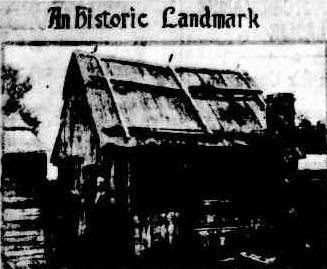The fourth attempt by the British to establish a settlement in the Northern Territory was at Escape Cliffs, situated near the mouth of the Adelaide River, northeast of Darwin.
The outposts were aimed at preventing Dutch or French settlements on the continent. Also, to take advantage of potential trade in the Asian region and to provide a port for shipping and shipwrecked sailors in the region. The Aboriginal people of the area, however, were not happy with the British presence.The Wulna People ( Djerimanga)
The area of Escape Cliffs settlement, the land of the Wulna people, is bordered by Larrakia territory.
According to William Lloyd Warner, anthropologist and sociologist, the Wulna had exogamous totemic groupings (marrying only outside clan or tribe) with no attached moieties or sections.
Clans, did not have the usual
larger groupings (sections, subsections, and semi-moieties) found in the greater
part of Australia. Warner also noted that: "a man marries his mother’s brother’s daughter but not his father’s sister’s daughter, and a woman her father’s sister’s son but not her mother’s brother’s son" (Warner 1933:73).
One of the elders that Warner spoke to
belonged to the Frog totem. His father was a Frog, his mother a Crocodile. A man's totem required him to marry into another group. The elder said: “Frog cannot marry Frog.”
 |
| Ceremony of the Frog Totem, Leader (Melbourne, Vic. : 1862 - 1918, 1935), Saturday 25 January 1902 |
The Wulna people also had avoidance practices, such as a mother-in-law taboo. Such practices amongst Australian Aboriginal people usually involves a ban on talking directly to the mother-in-law or even seeing her.
The doctor with the Escape Cliffs’ survey
expedition, Ebenezer Ward, described the Aboriginal people of the area as "wild children of the bush" and that they "roamed at will all their lives" over the land.
On a boating
trip from Port Darwin to Escape Cliffs in 1874, sailing in the
Amelia, a the party of six from the Northern Territory Times office saw three Aboriginal people who were "very timid and made their escape into the scrub". They also saw an Aboriginal burial place, the body wrapped in paperbark and bound with grass and placed on a raised platform in a tree. (Northern Territory Times, 8 May 1874)
 |
| Wrapping the body in paperbark, NT, Sydney Mail (NSW : 1912 - 1938), Wednesday 1 August 1917 |
 |
| Tree burial, NT, Sydney Mail (NSW : 1912 - 1938), Wednesday 1 August 1917 |
Wulna descendants are contained to three distinct family groups; Browne, Talbot and Kenyon. Wulna descent group was important to the (1991) Limilngan Wulna Land Claim processes.
1600s: Some Visitors and Explorers
Luís Vaez de Torres sailed to the north of Australia, through Torres Strait, charting New Guinea's southern coast and possibly sighting Cape York in October 1606.
In 1636, the ships Cleen Amsterdam and Wesel sailed west along the northern coastline of the Cobourg Peninsula and Melville Island, calling the land Van Diemen Land. The charts made during this voyage do not survive.
Makassar
people of today's Indonesia were sourcing trepang (sea cucumber) from northern Australia from somewhere around 1750. This trepang was sent to China, where it was regarded as a delicacy and aphrodisiac.
 |
| Photo of the relica of the Duyfkenunder sail, taken around 2006. The original Duyfken was commanded by Willem Janszoon as was the first European ship to have contact with Australia, in 1606, when they charted 300 kilometres of west Cape York. Rupert Gerritsen |
Captain Dumont D'Urville visited Australia various times between 1824 and 1840. In 1826, sailing in the
Astrolabe, he possessed secret orders to find a site for a French penal colony and naval base on the Australian coast. D'Urville later visited the Victoria
Settlement, Port Essington, in 1839.
The Portuguese colonised East Timor in the 17th century and would travel to the Bathurst and Melville Islands to capture Tiwi people for slavery until at least the beginning of the nineteenth century.
Former Failed Settlements
Fort Dundas (1824–1828)
Fort Wellington (1827-1829)
Port Essington (1838–1849)
Escape Cliffs (1864–1867)
1839: Escape Cliffs
On September 9th, 1839, H.M.S.
Beagle, under Commander J.L. Stokes, landed at the mouth of the Adelaide River, at the bottom of low cliffs, to compare compasses.
Fitzmaurice and Keys were comparing the compasses when a group of Aboriginal people came into view on the cliff
above them and threatened them with spears. A boat was sent to collect Fitzmaurice and Keys, who ran and swam for their lives, with the Aboriginals pursuing them. Dancing was also involved. Read below.
 |
MESSRS. FITZMAURICE AND KEYS DANCING FOR THEIR LIVES.
L.R. Fitzmaurice, del. London, Published by T. & W. Boone, 1846. |
Stokes, John Lort (1846). Discoveries in Australia
The incident as written by John Stokes (RN):
"A few days after my interview with the natives, 'Mr. Fitzmaurice went ashore to compare the compasses. From the quantity of iron contained in the rocks, it was necessary to select a spot free from their influence. A sandy beach at the foot of Escape Cliffs was accordingly chosen. The observations had been commenced, and were about half completed, when on the summit of the cliffs, which rose about twenty feet above their heads, suddenly appeared a large party of natives with poised and quivering spears, as if about immediately to deliver them. Stamping on the ground, and shaking their heads to and fro, they threw out their long shaggy locks in a circle, whilst their glaring eyes flashed with fury as they champed and spit out the ends of their long beards.* (*Footnote. A custom with Australian natives when in a state of violent excitement.) They were evidently in earnest, and bent on mischief.""It was, not a little surprising to behold this paroxysm of rage evaporate before the happy presence of mind displayed by Mr. Fitzmaurice, in immediately beginning to dance & shout, though in momentary expectation of being pierced by a dozen spears. In this he was imitated by Mr. Keys, who was assisting in the observations, & who at the moment was a little distance off & might have escaped. Without, however, thinking of himself, he very nobly joined his companion in amusing the natives; and they succeeded in diverting them from their evident evil designs, until a boat landing in a bay near drew off their attention.""Messrs. Fitzmaurice and Keys had firearms lying on the ground within reach of their hands; the instant, however, they ceased dancing, an attempted to touch them, a dozen spears were pointed at their breasts. Their lives hung upon a thread, and their escape must be regarded as truly wonderful, and only to be attributed to the happy readiness with which they adapted themselves to the perils of their situation. This was the last we saw of the natives in Adam Bay, and the meeting is likely to be long remembered by some, and not without pleasant recollections; for although, at the time, it was justly looked upon as a very serious affair, it afterwards proved a great source of mirth." (John Lort Stokes, Discoveries in Australia)1864: A Northern Capital. The Fourth AttemptThe British attempted to
establish a settlement in Australia's north a fourth time. The ships
Henry Ellis,
Beatrice and
Yatala set out with Colonel Boyle Travers Finniss, the first Government Resident of the Northern Territory.
Finniss had
instructions to explore the Adelaide River and the nearby coast and to select a site for a northern capital. Ignoring the advice of others, Finniss
chose the mosquito-infested mud-flats of Adam Bay.
 |
| Colonel Boyle Travers Finniss |
Finniss believed that Escape Cliffs was a superior site for settlement to Darwin, which he described as "landlocked, shut in by rocks on the north side, and encompassed in the form of a horse-shoe, towards all other quarters by low mangrove shores".
Arriving at Adam Bay, 21 June 1864, with 40 men (surveyors, deputy surveyors, draughts-men, chainmen, survey hands, boatmen, carpenters and a blacksmith), stores and livestock, the job began of
establishing a northern capital.
 |
| Escape Cliffs Northern Territory, looking north east, NT |
The settlement, located east of today's Darwin, was to be known as Palmerston, named after Lord Palmerston, the British Prime Minister. However, the site was poorly chosen, and serious conflict with the Aboriginal people occurred during the two years that
the settlement lasted.
 |
| Escape Cliffs, Palmerston, North Australia, Illustrated Sydney News (NSW : 1853 - 1872), Saturday 15 September 1866 |
The men included, J. T. Manton (chief surveyor), Stephen King and William Patrick Auld (King and Auld had been on the Stuart expedition
across the continent only two years previously). Frederick Litchfield, William and Gilbert McMinn, John Davis (was part of the McKinlay's expedition, from Adelaide to the Gulf and Bowen in 1862), F. J. Packard, E. Ward (postmaster).
The below newspaper article from 1865 mentions some of the problems afflicting the settlement:
"Escape Cliffs are situated from five to six miles from the
mouth of the Adelaide River, in a north-easterly direction.
The country viewed from seaward is particularly uninviting,
it being low and completely shrouded by thick mangroves,
except for about half a mile in front of the cliffs. The
country rises gradually to the cliffs on either side,
which extend for about a mile, the greatest elevation
being 30 feet. The country at the back of the cliffs
dips inland, and is bounded at the back at the
distance of about three miles by a fresh water swamp, a
mangrove-lined salt swamp and creek bounding this site to
the north, so that the extent of table land available for a
capital town with its suburbs and park lands is but very
small indeed. Extending on either side of the cliffs as far
as the eye can reach, and running parallel with the coast,
is a mud flat three-quarters of a mile wide, and this is
fringed on the outside by a coral reef. This flat is left ex
posed at every receding tide, cutting off all communication
with vessels by boat except at high tide. The mud has been
disembogued by the Adelaide River, and is of a very soft
and boggy nature, rendering it impossible to cross. No
permanent water in the shape of creeks or lagoons exists on
this site, and supplies have to be drawn from wells— an
objectionable source in any town. Nor does any
building-stone exist on the site nor for miles
around. Timber, again, for building purposes is as scarce
as stone. When these objections are summed up, our
conclusions at to the unsuitableness of this site are fully warranted."
1865 '[From our own Correspondent.]', South Australian Weekly Chronicle (Adelaide, SA : 1858 - 1867), 7 January
The paddle-steamer,
South Australian,
arrived on 5 December 1864 with more surveyors, including R. H. Edmunds and H. D. Packard, along with the first women, Mrs Packard and Mrs Bauer.
 |
| News (Adelaide, SA : 1923 - 1954), |
Jefferson Stow's Displeasure
Jefferson Stow, a land agent from South Australia, also arrived, representing some investors in the scheme. Basically, Stow hated the place and Finniss on sight.
Stow penned a letter to The South Australian Register of 31 July 1865, voicing his displeasure, stating, "Mr Finniss has by his incapacity and misconduct brought the Northern Territory enterprise to the brink of failure."
Finniss was unpopular with his men as he
wanted them to spend much of their time exploring and guarding the stores, which they found tedious.
Though the stores needed to be guarded according to a report in the South Australian Register:
"The natives are numerous and
troublesome, being very much given to appropriating
our property to their own-uses or purposes. There
has already been one skirmish with them, in which
Mr. Pearson received three spear wounds— one
piercing his right side, a second his left arm below
the elbow, and a third giving him a scalp wound
above the right ear. Fred Litchfield received a wound
or rather a bruise on the left arm from a stone
pointed spear."South Australian Register (Adelaide, SA : 1839 - 1900), Wednesday 12 October 1864
 |
| Escape Cliffs, NT |
 |
| Lithographic print depicting the settlement at Escape Cliffs in the Northern Territory. B.T.Finniss led an expedition which arrived there in 1864. Printed text beneath the image reads 'Escape Cliffs, Northern Territory', while the number '17' is written in the top right corner. Includes a photograph of the same image although believed to be a proof print, with the words 'Printed by W.Newport, Adelaide', a lithographer who worked in SA in the 1860s, beneath the image. The print depicts a scene set above low cliffs. A campsite of tents and some huts have been set under the trees. A few people can be seen walking around the campsite. Two pandanus trees lying at an angle can be seen in the foreground. Approximately 1865-1866, SLSA |
 |
| Escape Cliffs settlement, Government House - man with gun is D.T. Manton, circa 1865, State Library of South Australia |
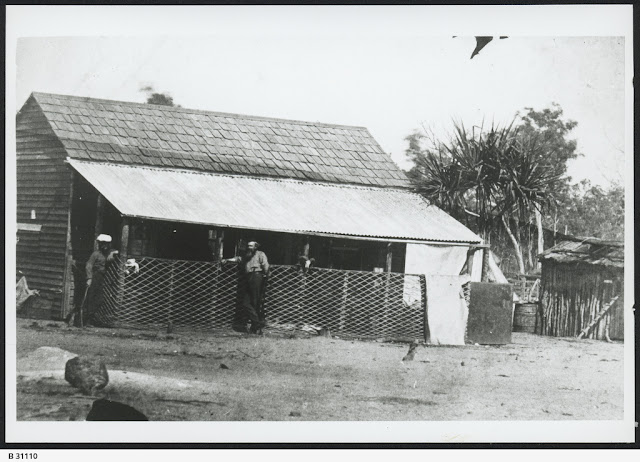 |
| The storekeeper's house., circa 1866, Escape Cliffs Collection, SLSA |
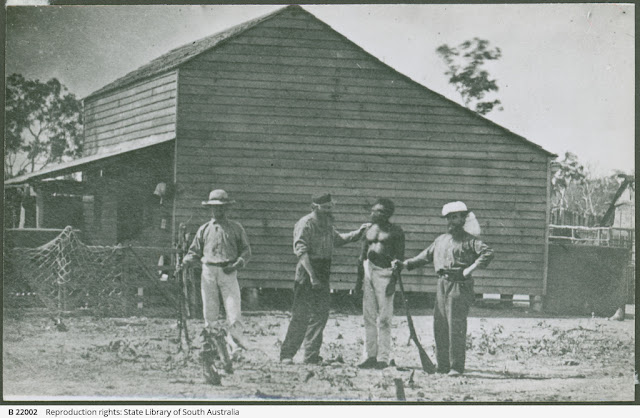 |
Escape Cliffs settlement - Doctor's residence. State Library of South Australia, n.d.
|
 |
| Post Office at Escape Cliffs Settlement, NT. Escape Cliffs Settlement, the site of the fourth attempt to establish a settlement in the Northern Territory. It was situated near the mouth of the Adelaide River, north east of Darwin. It was abondoned in 1867 following conflicts with the local Marananggu people. The man with a gun is Clement Young, clerk and accountant to the Northern Territory Survey in 1865-66. |
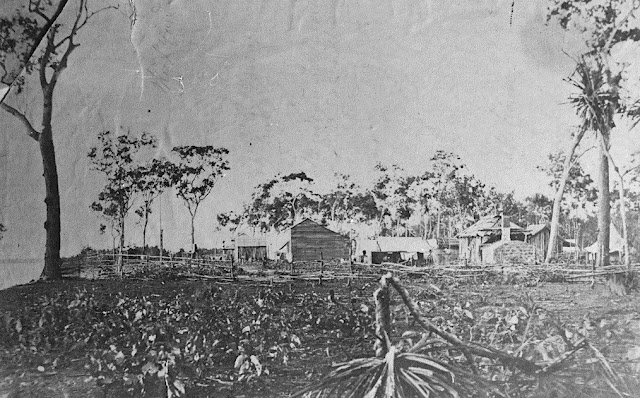 |
| Escape Cliffs Settlement was the site of the fourth attempt to establish a settlement in the Northern Territory. It was situated near the mouth of the Adelaide River, circa 1865 |
Revenge
Alaric Ward shot an Aboriginal man in 1864, resulting in the Aboriginal people later taking revenge on him by spearing and bludgeoning him to death on 31 July 1865.
The Aboriginal people also mounted another raiding party, spearing several horses, resulting in Finniss sending an armed party out to Chambers Bay (some 8 miles (13 km) distant). However, while the Aboriginals had fled their camp, one elderly man named Dombey was shot in the back. The armed party then retrieved as
much property as they could, before setting fire to the Aboriginal dwellings.
Escape
A group of seven men at Escape Cliffs had finally had enough of the situation. And in May 1865, seven men, including Jefferson Stow, fled to Champion Bay, Western Australia, in a small open boat dubbed the
Forlorn Hope.
With only a pocket compass to guide the men, they
travelled in an open boat from Adam Bay, Northern Territory, to Champion Bay, Western Australia -a distance of some 2,000 miles (3,200 km). They survived storms, violent seas, seasickness and damage to the vessel.
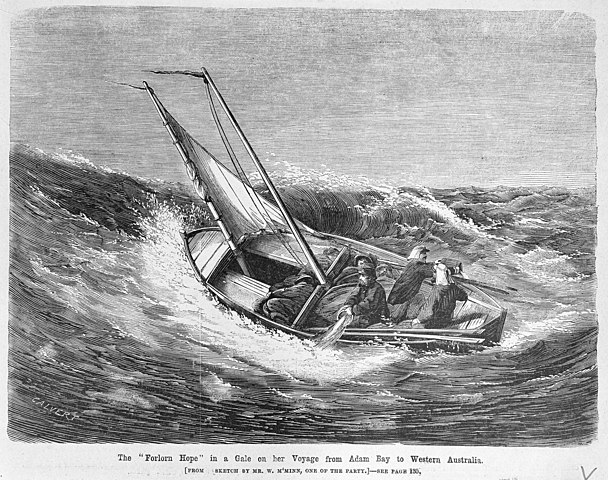 |
A wood engraving as published in a Melbourne magazine in 1865, depicting a small open boat in heavy
seas. Seven men are aboard: three sitting up and four lying down
When Jefferson Stowe arrived in Adelaide, he reported on the situation at Escape Cliffs, resulting in Finniss being recalled and Chief-Surveyor J. T. Manton being appointed Government Resident in his place. |
 |
| Mr. Jefferson P. Stow, Observer (Adelaide, SA : 1905 - 1931), Saturday 9 May 1908 |
1865: Further ExplorationsJohn McKinlay was sent in September 1865 as the leader of a party of twelve to explore the Northern Territory, aiming to find a more suitable site for settlement than Escape Cliffs.
 |
| John McKinlay (1819-1872) |
The exploration party was on the East Alligator River during the rainy season, surrounded by floodwaters and surrounded by crocodiles, when McKinlay decided to kill the horses and construct a raft with their hides and some saplings.
Sailing with only rotting horseflesh to eat and crocodiles snapping at the hides, the party spent 15 horrific days at sea until the 5 July, when they reached Escape Cliffs.
McKinlay, however, made
favourable reports about the area, Port Darwin and Anson Bay, as being suitable for settlement.
 Craftbuilt Craft built by R.H. Edmunds as it lay at Escape Cliffs, Northern Territory, 1866 [picture] / Lieut. Guy R.N, Libraries Australia Craftbuilt Craft built by R.H. Edmunds as it lay at Escape Cliffs, Northern Territory, 1866 [picture] / Lieut. Guy R.N, Libraries Australia |
On 22 December 1866, Captain Cadell arrived on the paddle steamer Eagle at Escape Cliffs, with orders to abandon the settlement.
 |
| Captain Cadell, Observer (Adelaide, SA : 1905 - 1931), Saturday 2 February 1907 |
In the following year, Captain Cadell spent seven months exploring north-east Arnhemland and to the west between Adam Bay and the Victoria River. He recommended a settlement site near the Liverpool River, but his report "failed to arouse any enthusiasm".
However,
enthusiasm was soon reignited, and on 27 December 1868, another party of surveyors sailed from Adelaide for the north, with George Woodroffe Goyder, the Surveyor-General of South Australia, onboard.
 |
| George Woodroffe Goyder (1826-1898), surveyor-general |
Goyder was to become the "Father of Darwin". The new settlement at Darwin Harbour, 45 kilometres from Escape Cliffs, was settled relatively peacefully.
1890s
 |
| Bakery chimney from the ruins of Escape Cliff, Hotham Point, Adelaide River, ca. 1897, NLAUST |
 |
| Beach at Escape Cliffs, Hotham Point, Adelaide River, ca. 1897, NLAUSt |
Getting There
The former site of the settlement at Escape Cliffs is located in Djukbinj National Park and is difficult to access.
After the settlement of the Wulna Land Claim, the Limilngan-Wulna Aboriginal Corporation leased the land back to the former Conservation Commission of the Northern Territory to use for "the purposes of a national park".
You can sail from Darwin
around the coast and cross the Adelaide River estuary, but the land cannot be accessed.
Around Escape Cliffs
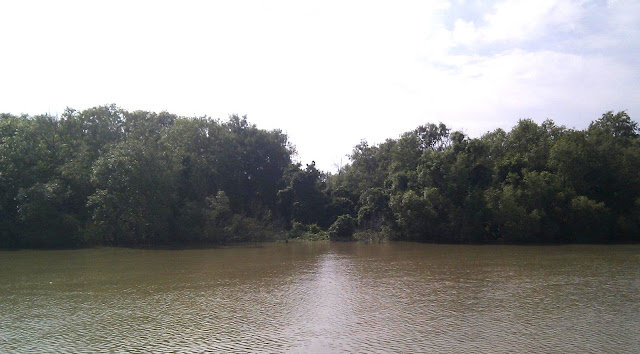 |
| Adelaide River, NT |
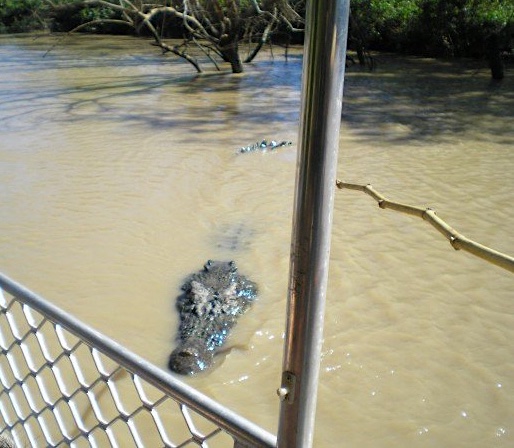 |
| Adelaide River, NT |
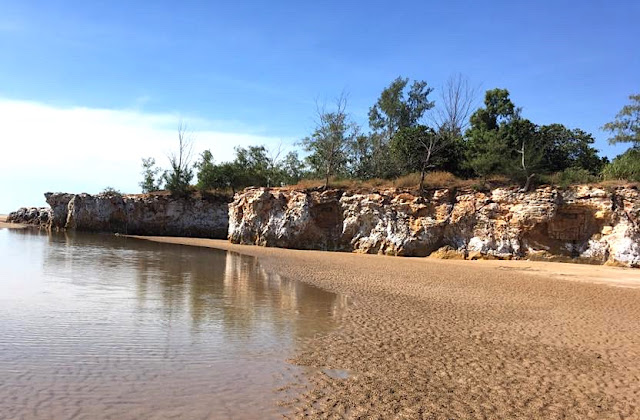 |
| Adelaide River, NT |



